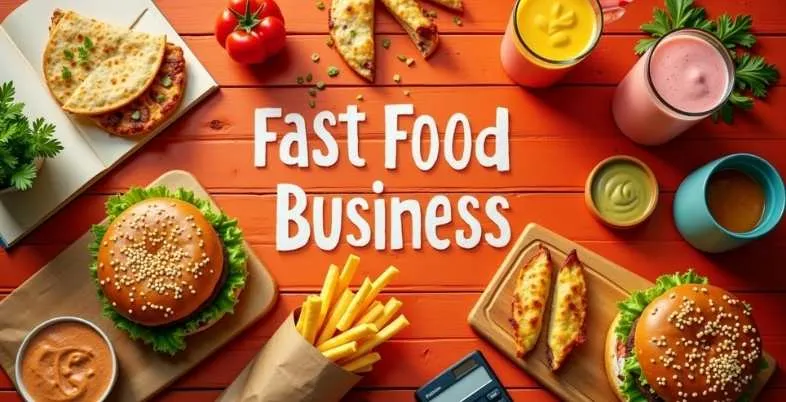The rapid growth rate in the Indian fast food sector is being pushed by the changing lifestyle, urbanization, and rising disposable income. The fast food restaurant industry has emerged as a gold rush to aspiring business men and women intending to invest in the changing food culture phenomenon in the country. Fast Food Business Ideas are transforming the manner in which Indians eat and interact from traditional street food to contemporary fusion ideas.
Fast food enterprises are very profitable ventures that have a convenience element, cheap prices and a wide variety of food. As new food delivery services emerge and modify the preferences of the consumers towards fast food, entrepreneurs now have a limitless chance to build a lucrative food enterprise. Whether it’s launching independent outlets or exploring Fast Food Franchises, being a first-time business owner or a person who already has experience in the restaurant industry, knowing the fast food business opportunities landscape is one of the key success factors in the competitive yet lucrative market.
Brief on India’s Growing QSR
India’s QSR market is expected to reach $27.8 billion by 2025 and $43.5 billion by 2030, growing at a 9.36% CAGR. The organised segment, led by major QSR chains, is expanding rapidly at a 15% CAGR (2023–2026), driven by rising demand for convenient dining. The biggest cities in the US such as Mumbai, Delhi, Bangalore, and Pune are on the forefront in the revolution, with tier-2 and tier-3 cities lagging close behind.
Population explosion that was born out of the demographic dividend (a greater portion of India’s population being below 35 years) has resulted in an enormous customer base that favors fast, cheap, and quality cuisine. The onslaught of digitalization and the rise of food aggregators such as Swiggy and Zomato have only increased growth and delivered food to millions of people, showcasing how the Zomato Business Model has transformed the food delivery ecosystem.
Homegrown brands represent a high degree of international brands. The pandemic increased the innovation of cloud kitchens, making it easier in terms of entry barriers to become an entrepreneur operating under Fast Food Business Ideas, which require lower capital contributions.
Why Start a Fast Food Business in 2026?
- Huge Market Potential: The Indian QSR market is also growing at a high rate due to the increasing urbanization and nuclear families in search of convenient meals as opposed to cooking them at home.
- Minimal Barriers to Entry: Fast food businesses have minimal capital requirements, less required space, and less complicated activities and entrepreneurship is easy because of comparatively low entry requirements.
- High Profit Margins: There are high profit margins in many fast foods particularly beverages, snacks and most common food sold in the streets with a margin of 40-70% profits which ensure quick returns.
- Digital Integration: Food delivery apps have removed geographical boundaries, where even small businesses will be able to reach customers within cities without necessarily having expensive dine-in infrastructure.
- Adjustable Business Models: Businessmen/women have options such as kiosks, food trucks, cloud kitchens, franchise, or a conventional outlet depending on their budget and vision.
- Modification of Consumer Behavior: Dual-income families, busy lives, and the need to eat out due to preferred convenience over preparing meals at home have left a steady influx of demand for quick-service foods.
Comparitieve View of Top 20 Fast Food Business Ideas
| Sr No | Fast Food Business Ideas | Startup Cost (₹) | Profit Margin (%) | Scalability (1–5) | Ideal For |
| 1 | Momos Corner | 50,000 – 2 lakh | 50–65% | 4 | Small stalls / kiosks |
| 2 | Pizza Outlet | 3 – 8 lakh | 45–60% | 5 | Franchise / cloud kitchen |
| 3 | Burger Joint | 2 – 5 lakh | 50–70% | 5 | Urban & campus areas |
| 4 | Chaat & Street Food Stall | 30,000 – 1.5 lakh | 60–75% | 4 | Local markets & streets |
| 5 | Sandwich & Wrap Counter | 80,000 – 3 lakh | 55–70% | 4 | Offices / metro zones |
| 6 | Biryani Cloud Kitchen | 2 – 6 lakh | 40–55% | 5 | Online delivery model |
| 7 | Juice & Smoothie Bar | 1 – 4 lakh | 60–80% | 4 | Health-conscious crowd |
| 8 | Paratha & Roll Outlet | 1 – 3 lakh | 55–65% | 4 | Breakfast & dinner markets |
| 9 | Dosa / South Indian Outlet | 1.5 – 4 lakh | 50–65% | 4 | All-day dining spots |
| 10 | Frankies & Kati Rolls | 50,000 – 2 lakh | 60–70% | 4 | College & office areas |
| 11 | Ice Cream & Dessert Parlor | 3 – 10 lakh | 55–70% | 5 | Malls & high-traffic areas |
| 12 | Chinese Fast Food Corner | 1.5 – 4 lakh | 50–65% | 4 | Takeaway / delivery |
| 13 | Pav Bhaji & Mumbai Street Food | 40,000 – 1.5 lakh | 65–75% | 4 | Urban + residential areas |
| 14 | Fries & Loaded Fries Kiosk | 80,000 – 2.5 lakh | 60–75% | 4 | Youth & mall zones |
| 15 | Tea & Coffee Café | 1 – 4 lakh | 70–85% | 5 | All demographics |
| 16 | Pasta & Continental Outlet | 2 – 5 lakh | 50–65% | 4 | Premium locations |
| 17 | Shawarma & Kebab Counter | 1.5 – 4 lakh | 55–70% | 4 | Urban nightlife areas |
| 18 | Healthy Salad Bar | 2 – 6 lakh | 50–70% | 4 | Fitness & office zones |
| 19 | Chole Bhature / North Indian Snacks | 1 – 3 lakh | 55–70% | 4 | Lunch & family market |
| 20 | Waffle & Pancake Stall | 1 – 3 lakh | 60–75% | 4 | Malls / college areas |
Top 20 Fast Food Business Ideas in India (High-Margin & Trending)
1. Momos Corner
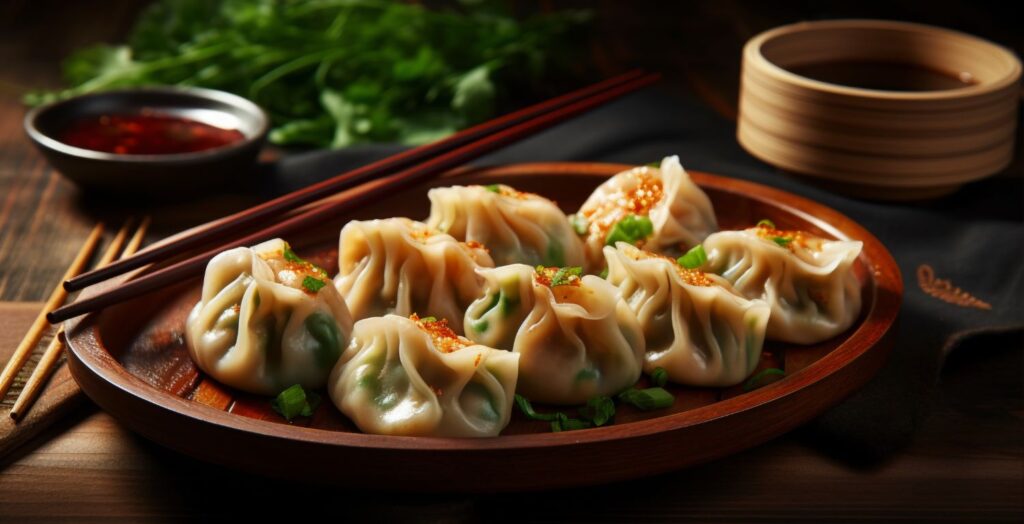
Momos have become a street food of Indian popular culture, not just with Tibetan roots but being a pan-Indian phenomenon. These are steamed or fried vegetables, chicken or paneer-based dumplings, or more of a new flavor such as chocolate or cheese, which attracts many age groups.
A momos corner does not need a large infrastructure as it only requires a steamer, a working area, and a counter. The preparation styles (steamed, fried, tandoori, or pan-fried) and the accompaniments (such as spicy chutneys) are versatile, which means that the menu can never get monotonous. Moreover, those inspired by successful brands often research Wow Momo Franchise Cost to understand how profitable such ventures can be. Therefore, this is one of the most lucrative Fast Food Business Ideas in India.
- Startup Cost Estimate: ₹50,000 – ₹2 lakhs
- Profit Potential / Margin: 50-65%
2. Pizza Outlet
Pizza is still one of the most preferred fast foods in India with international and domestic players in taking advantage of this market segment. A small pizza shop will be able to serve the families, the students, and the office-holders with their custom orders. Its secret of success is to include unique toppings that combine Indian taste with the classic Italian ideas. The thin crust, cheese burst, regional differences such as paneer tikka or tandoori chicken pizzas appeal to different customers. Pizza companies with good sourcing and good operations have good margins and develop a strong loyal customer base with regular quality.
- Startup Cost Estimate: ₹3 – 8 lakhs
- Profit Potential / Margin: 45-60%
3. Burger Joint
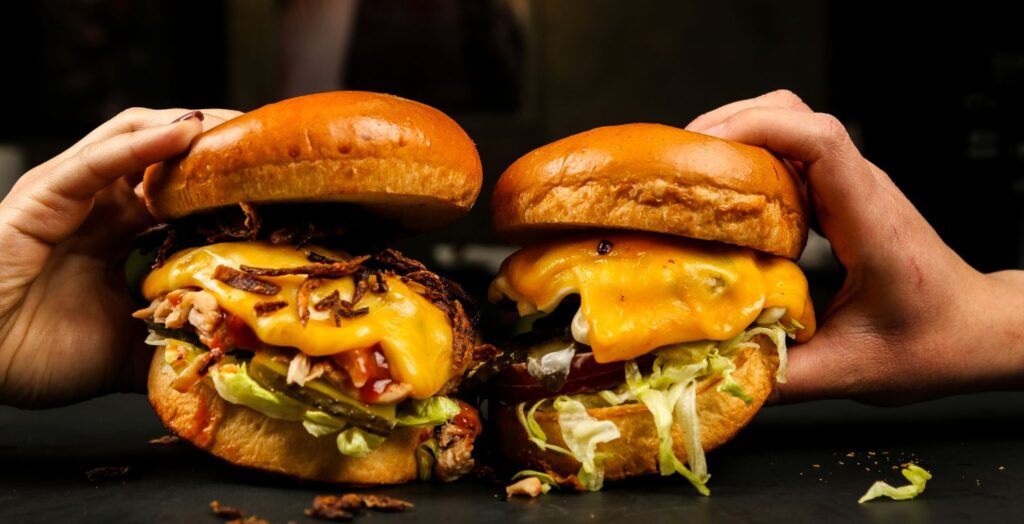
Burgers have metamorphosed to American imports to Indian staples with myriads of other variations that can suit the local tastes. A burger shop can distinguish by offering different types of patty, aloo tikki, paneer, chicken, mutton, or new vegetarian ones. The comparatively easy method of preparation, standard recipes and the potential quantities make burgers great Fast Food Business Ideas.
Quality, signature sauces, the golden proportion of buns to patties, and appealing packaging would give them an edge. Dine-in/takeaway models are equally good with the high combo menu that is bound to drive mean order value high.
- Startup Cost Estimate: ₹2 – 5 lakhs
- Profit Potential / Margin: 50-70%
4. Chaat & Street Food Stall
The traditional Indian chaat means traditional Indian flavors with nostalgic and comforting effects. Since pani puri to bhel puri, papdi chaat to dahi puri, these sour and spicy snacks need no explanation about their mind-reading mass appeal. A chaat booth does not need a lot of investment – simple utensils, fresh products and a favorable location. The attractive nature of this type of business is the customization of the products, in which the customers can order the spices and additives accordingly. This is one of the most available and lucrative businesses in the fast food industry as the chaat businesses hold repeat customers every day with quick service, cleanliness, and new-fangled presentations.
- Startup Cost Estimate: ₹30,000 – ₹1.5 lakhs
- Profit Potential / Margin: 60-75%
5. Sandwich & Wrap Counter
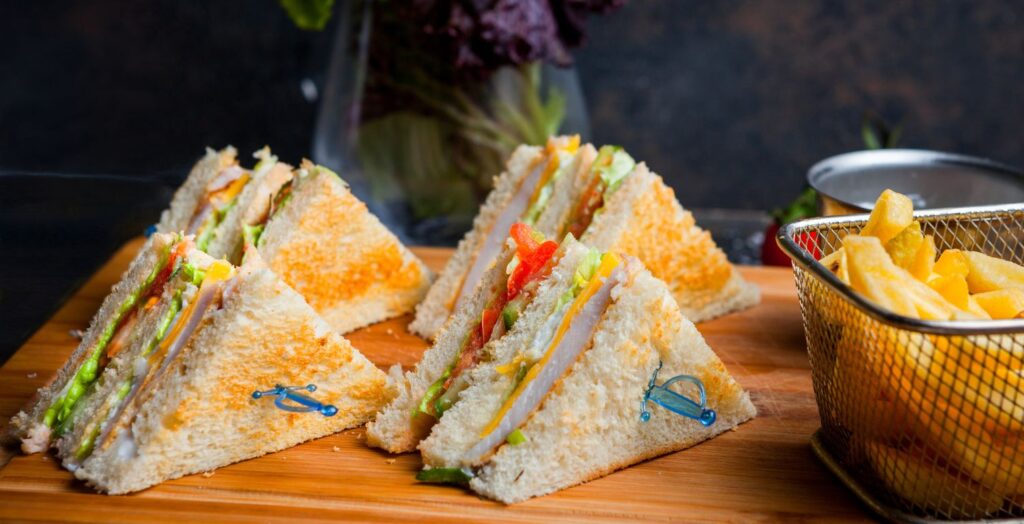
The sandwiches and wraps are offered to health conscious buyers who are interested in getting fast, nutritious, and full meals. This is an all-inclusive concept that can accommodate any dietary preference, any of them are vegetarian, non-vegetarian, vegan, and protein-rich. There is a wide menu choice of grilled sandwiches, cold sandwiches, clubs, wrap sandwiches with fresh vegetables, grilled meats or paneer and typical sauces.
The short time in preparation, convenience and the perception that this is a healthier alternative of fast food will place this business in a good stand. This is sustainable and scalable due to their ability to operate in small locations using slight equipment.
- Startup Cost Estimate: ₹80,000 – ₹3 lakhs
- Profit Potential / Margin: 55-70%
6. Biryani Cloud Kitchen
The unmatched popularity of Biryani all over India is a foolproof business plan especially in the cloud kitchen scheme. There is no need to have a brick and mortar store since delivery platforms are available to the customer, which saves costs. Giving regional varieties like Hyderabadi, Lucknowi, Kolkata or Mumbai style, to wider markets, and vegetarian and egg ones are some of the ways to capture more markets. It all depends on genuine cooking, high quality ingredients, ideal mixes of spices, and the adequate portioning. Biryani cloud kitchens are highly profitable since the average order values are high and their repeat purchases are frequent when paired with such complementary products as raita and kebabs.
- Startup Cost Estimate: ₹2 – 6 lakhs
- Profit Potential / Margin: 40-55%
7. Juice & Smoothie Bar

Trends of health consciousness and wellness have moved the juice bars on to the fast food mainstreams. Fresh juice drinks, vegetable juice drinks, detox juice, protein drinks and immunity builds appeal to fitness enthusiasts at the workplace, health conscious families.
The business needs to have good juicers, refrigeration, fruits, and a nice presentation. Customization can be provided in the form of sugar-free, organic, or superfood and other additions such as chia or spirulina segments are created, thereby creating premium segments. Perceived value of health drinks is high, which enables a high premium price but the costs of ingredients are moderate. The menu is made to be exciting due to seasonal specialties and creative combinations which lead to customer retention.
- Startup Cost Estimate: ₹1 – 4 lakhs
- Profit Potential / Margin: 60-80%
8. Paratha & Roll Outlet
Both parathas and rolls have both convenience and good yielding gratifying food which has been attractive to the low end consumer who enjoys large food portions. Stuffed parathas are prepared aloo, paneer, gobi, mixed vegetable or non-vegetarian selections, served with curd, pickle and butter, which appeal to breakfast and dinner time customers. Tikka, kebabs, or scrambled eggs rolled into rolls is a convenient way of eating. High turnover in peak hours, low food costs and easy ways of preparing are properties that keep the business going. Single stalls and small restaurants are both quite successful, and cloud kitchens in residential and office locations have a lot of prospects.
- Startup Cost Estimate: ₹1 – 3 lakhs
- Profit Potential / Margin: 55-65%
9. Dosa & South Indian Fast Food
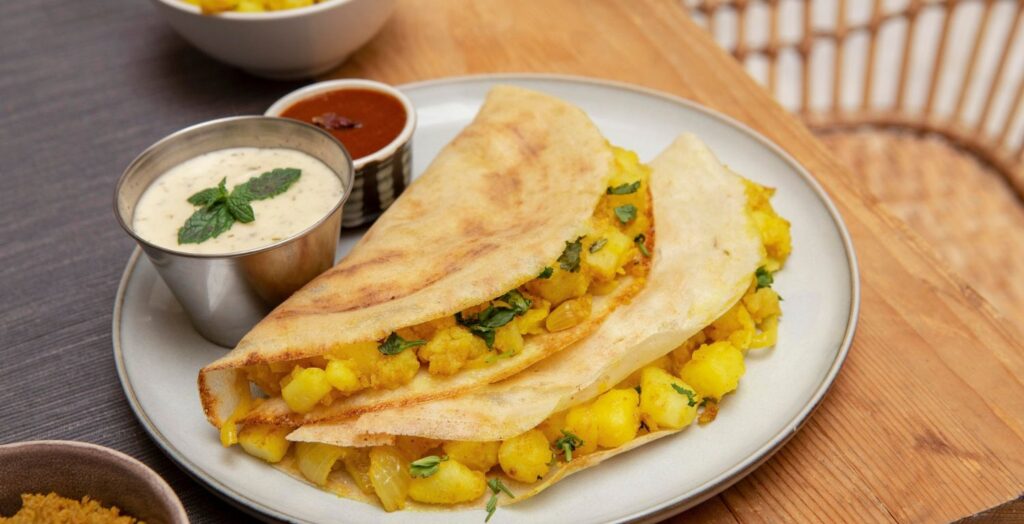
The food of South Indians is not restricted by any region as dosa, idlis, vadas as well as uttapams have become nationwide. A fast food restaurant that serves south Indian food takes care of breakfast, lunch, and dinner markets, offering rather healthy, low-cost products. The preparation of the fermented batter requires prior planning but gives various cuisines to be served such as plain dosas, masala dosas, cheese dosas, Mysore dosas, rava dosas and some novel fusion types of dosas.
The accompaniments such as sambar, coconut chutney and tomato chutney make the experience complete. This model is sustainable through adhering to perceived healthiness, vegetarian emphasis and the competitive pricing with a dedicated customer population.
- Startup Cost Estimate: ₹1.5 – 4 lakhs
- Profit Potential / Margin: 50-65%
10. Frankies & Kati Rolls
Frankies and kati rolls are the idealization of street food, as they are very portable, filling, and flavored. These wrap types of meals have rotis or parathas stuffed with spicy vegetables, paneer, chicken, or mutton served with tangy sauces and crunchy onions. It is an excellent business model in terms of late-night, college campuses, office areas and high traffic locations. It is one of the most effective Fast Food Business Ideas because it can be prepared quickly, does not require many seats, and has a high take-off possibility. The key to success is signature marinades, fresh products, wrapping styles, and uniform taste of the meals within a preparation lot.
- Startup Cost Estimate: ₹50,000 – ₹2 lakhs
- Profit Potential / Margin: 60-70%
11. Ice Cream & Dessert Parlor

The ice cream shops are exploiting the developing culture on dessert and the rising disposable incomes in India. Several sources of revenue are provided by the provision of a variety of flavors; traditional, international, sugar-free, and regional delicacies, as well as, sundaes, shakes, and new desserts.
The air-conditioned rooms also have customers during summers, contrary to the myths the business operates all the year round as opposed to seasonal demand. Franchised brands offer well-tested systems whereas independent salons have the freedom to explore novel tastes and crafts. This is profitable and fun due to the high markup of ice cream which is relatively low to spoil in case it is managed well and the fact that it is enjoyed by families.
- Startup Cost Estimate: ₹3 – 10 lakhs
- Profit Potential / Margin: 55-70%
12. Chinese Fast Food Corner
Indo-Chinese food has been integrated into the Indian fast food system as most of their cuisine such as Manchurian, fried rice, noodles, momos have become the dominant foods served in the quick-service market. Chinese fast food outlets do not need large areas and can be based in small spaces, they serve takeaway and home delivery instead of elaborate restaurant decorations. The secret is in attaining genuine flavors, with due wok cooking, quality of the sauces, and fresh vegetable ingredients. Noodles and manchurian, fried rice and chili paneer/chicken combo meals are added to the average bills. The popularity of the cuisine with young and old people as well as geographically makes it a stable one among Fast Food Business Ideas.
- Startup Cost Estimate: ₹1.5 – 4 lakhs
- Profit Potential / Margin: 50-65%
13. Pav Bhaji & Mumbai Street Food
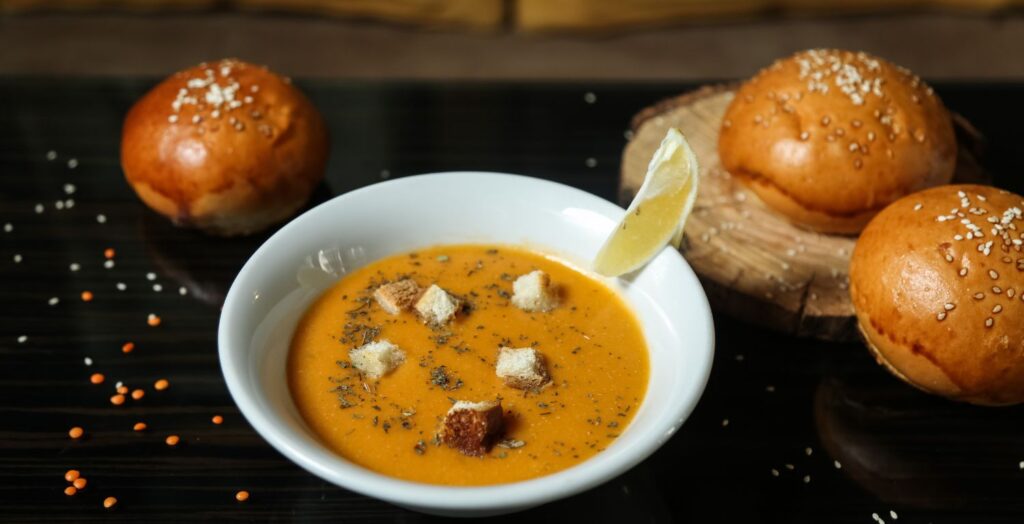
The representative of Mumbai street foods, especially the pav bhaji, enjoys national recognition with its good buttery taste and low costs of its products. Vada pav, missal pav and dabeli can also be provided in a specialized stall which makes it a complete experience of Mumbai street food. Spiced vegetable mash with butter-roasted pav bread appeals to customers who need comfort foods.
The cost of operation is also low because ingredients are also vegetable based and readily accessible. It has a high turnover rate during the evening time and this is mainly along the colleges, offices and residential places that generate so much money on a daily basis. When cheese is added, paneer is added, or specialty variations are added, they form high-end variants without altering the base product.
- Startup Cost Estimate: ₹40,000 – ₹1.5 lakhs
- Profit Potential / Margin: 65-75%
14. Fries & Loaded Fries Kiosk
Fries no longer caters as a side dish and is now an individual fast food dish, particularly loaded fries, which have been gaining popularity. Fries kiosk has the opportunity to provide traditional, peri-peri and cheese, Mexican, tandoori and unlimited topping varieties, which appeal to the younger age group.
It has been prepared in a fairly simple fashion; fried and topped, which enables a high volume and speed. Small footprints are ideal in food courts, malls and multiplexes and even street corners. The novelty aspect of loaded fries in the form of creative presentation makes them very shareable in social media, which gives them organic marketing. Compared to selling prices, low ingredients cost will mean high margins.
- Startup Cost Estimate: ₹80,000 – ₹2.5 lakhs
- Profit Potential / Margin: 60-75%
15. Tea & Coffee Cafe

The culture of chai in India coupled with increased consumption of coffee provide ideal opportunities for beverage-oriented stores. Traditional masala chai, filter coffee, and contemporary versions such as green tea, herbal infusions, cold coffee, and specialty brews are some of the varieties that a tea and coffee café can offer. Sale of drinks with foods such as samosas, biscuits, and baked goods enhances the amount of revenue per client.
The business is very good close to offices, colleges, highways, and residential places where individuals need fast refreshment breaks. This is sustainable due to low costs on ingredients, high beverage margins, and because of the prospects in high customer turnover. Even the simplest of elements such as ambience and seating area are known to boost customer experience. Many entrepreneurs are even exploring models like the Chai Sutta Bar Franchise, which blends affordability with strong brand recognition, making it an ideal example of success in India’s growing tea café segment.
- Startup Cost Estimate: ₹1 – 4 lakhs
- Profit Potential / Margin: 70-85%
16. Pasta & Continental Outlet
Pasta and gourmet food is targeted to up-market people who are bored with the usual Indian fast-food. It can serve white sauce, red sauce, pink sauce pastas with garlic bread, soups and salads through a focused outlet. The apparent sophistication of the food of the continents permits a premium price but the cost of the ingredients and preparation are moderate. The idea is effective in high income neighbourhoods, business quarters and metro cities where the food culture of experiments is successful.
Efficient operations are formed by quick cooking time, standard recipes and good appearance of the presentations. The provision of vegetarian and non-vegetarian foods will maximize the coverage of the market to a wide range of customer preferences.
- Startup Cost Estimate: ₹2 – 5 lakhs
- Profit Potential / Margin: 50-65%
17. Shawarma & Kebab Counter

The Middle Eastern food especially the shawarma and the kebab have garnered fanatical admirers in the Indian cities. A counter that specializes in such can sell chicken, mutton or paneer shawarmas with homemade marinades, vegetables and special sauces. Kebabs (seekh, shammi or grilled), are also complementary items on menus. The shawarma is cooked on a vertical rotating spit that gives the appearance of appeal and regular cooking.
Small space operations with high takeaway and delivery driven operations are maximized to increase profitability. The business has an advantage of evening and late-night demand particularly in the vicinity of colleges, entertainment colleges, and residential neighborhoods. The positioning is premium and, therefore, the pricing can be better than in the traditional street food.
- Startup Cost Estimate: ₹1.5 – 4 lakhs
- Profit Potential / Margin: 55-70%
18. Healthy Salad Bar
The increasing health consciousness has presented a need for healthy and fresh alternatives to fast foods, and thus the positioning of the salad bars is appropriate. Provision of personalized bowls that include greens, proteins (grilled chicken, paneer, tofu) and nuts, seeds, and various dressings appeal to the fitness and health conscious working classes.
The company has the opportunity to venture into grain bowls, smoothie bowls as well as cold-pressed juices to situate offerings all in the name of healthy food. The quality ingredients, organic alternatives, and nutritional transparency justify premium pricing. Working in the corporate neighborhoods, fitness clubs, fitness centers, and rich neighborhoods would guarantee accessibility to the target audience. This is progressive Fast Food Business Ideas that is in line with the changing consumer consciousness with regard to nutrition and health.
- Startup Cost Estimate: ₹2 – 6 lakhs
- Profit Potential / Margin: 50-70%
19. Chole Bhature & North Indian Snacks
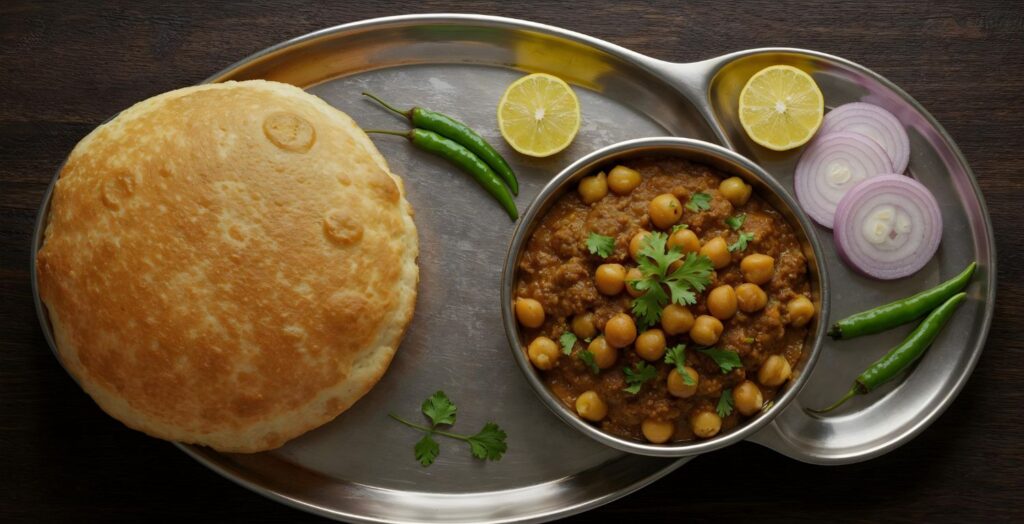
Chole, as it is abbreviated, the popular North Indian dish that combines spicy chickpeas with fried bread attracts masses of people who want to be satisfied with tasty, nutritious meals. Their special outlet may contain rajma chawal, kadhi chawal, and comfort foods of the Punjabi cuisine. The company operates under honesty, which consists of a correctly cooked legume, classic spice mixtures and fresh bhatures.
Working during lunch time will attract busy working people and families who want to have tasty vegetarian foods. The ingredient costs are relatively low and the generous amounts of food served to the customers lead to the generation of perceived value to the customers. The accompaniments such as lassi, pickles and onions take the olden time experience to complete. This idea is very successful in North Indian markets as well as in cosmopolitan cities.
- Startup Cost Estimate: ₹1 – 3 lakhs
- Profit Potential / Margin: 55-70%
20. Waffle & Pancake Stall
Waffles and pancakes are fast foods that are a hybrid dish of dessert and meal among the younger generation. The special stall will provide sweet substitutes such as chocolate, fruit, ice cream and nutella with savory ones consisting of vegetables and cheese. The aesthetics of the waffles makers and pancake flipping generate entertainment in the process of preparing the orders. The size of equipment needed and fairly straightforward preparation steps ensure that running operations is not complicated.
It is already the perfect business in the malls, food court areas, college campuses, and entertainment areas. Instagrammable presentations are the organic drivers of social media marketing. The value association can be explained by novelty, quality toppings, as well as the experiential value, which guarantees healthy margins besides specialty ingredients.
- Startup Cost Estimate: ₹1 – 3 lakhs
- Profit Potential / Margin: 60-75%
How to Start & Run a Small Fast Food Business: Step-by-step
- Carry out Market Research: Determine who you want to serve, competition, local preferences in the local food and demand trends in your target place.
- Develop Business Plan: Prepare a detailed paper that includes concept, market target, menu, pricing, projection of financial statements, a break even analysis and growth plans.
- Establish Finance and Budget: Determine total start up expenses in terms of equipment, license, inventory, and security deposits as well as working capital.
- Get License and Permits: FSSAI license, GST registration, municipal corporation trade license, fire safety certificate and pollution clearance where necessary.
- Select Strategic Location: In high foot fall locations such as near colleges, offices, residential complexes or commercial hubs. Weather visibility, accessibility, parking, the distance to competitors, and rental fees.
- Hire and Train: staff Hire cookers, helpers and counter staff depending on business size. Establish standard operating procedures so that every other activity is consistent particularly when scaling across Fast Food Business Ideas.
Marketing & Growth Hacks for Fast Food Businesses
- Use Food Delivery Aggregates: Collaborate with Swiggy and Zomato and other aggregates to reach out beyond the physical location. Optimize menu description, and make reviews active in order to keep the ratings and visibility on a high level.
- Social Media Interaction: Develop Instagram and facebook accounts that display food pictures, back-stages, reviews with customers, and promotions. Create an organically built community through the use of location tagging, trending hashtags and interactive stories to pull foot traffic.
- Include Combo Deals and Promotions: Develop value meals to include a side item and drink with main products at pleasing prices. Conduct short-time deals, seasonal discounts and festival marketing to generate urgency and experimentation in the new clients.
- Promote User-Generated Content: Offer discounts or feature the posts of the customers who share photos of their food on social media.
- Cooperation with Local Influencers: Find collaborators in food bloggers, micro-influencers, college ambassadors to promote the company.
Conclusion
The Indian fast food market has unbelievable prospects to investors who are ready to mix passion and strategy. What was once seen as old time street food, is now emerging as a new modern fusion concept based on the various budgets, level of skill as well as market taste. To be successful, it has to be able to accommodate the needs of the customers, to stay consistent in quality, adopt technology, and adjust to existing trends.
Fast Food Business Ideas are also good ventures because of the relatively low entry barriers, high profit margins, and the ability to scale the business given that the potential business is highly profitable. The demand for quality fast food will only increase as urbanization in India advances and people have switched their tastes to convenience.
With the help of selecting the appropriate idea, place, and execution, the would-be entrepreneurs will be able to create profitable business ventures that can ease the hungry people in addition to establishing their individual aspirations of becoming financially free and expressing their creativity in the vibrant food industry.
FAQs
What is the most profitable fast food business in India?
This is because goods that have low costs of ingredients and where consumers feel they cost more are the most profitable goods. Chaat, momos, tea/coffee and juice bars are usually capable of producing 60-80 percent profit.
How much investment is needed to start a small fast food business?
There is a wide range of investment in terms of concept and size. Minimum investment of 30,000-50,000 will be required in small stalls or kiosks and 2-10 lakhs in established ones with seating. Cloud kitchens also present middle-ground opportunities that need 1-5 lakhs hence entrepreneurship is available at all levels.
Do I need special training to start a fast food business?
Formal culinary education is not required though it is beneficial. Most of the highly successful entrepreneurs teach themselves by working, using online materials and employing trained cooks.
Which licenses are mandatory for fast food businesses?
Any food business in India is not obligatory without the FSSAI license. Also required is GST registration (when you have a turnover surpassing threshold), municipal trade license as well as any fire and health department clearance you may have depending on your location and size of your business.
How long does it take to break even in a fast food business?
Timelines used in break-even depend on the investment, location, and efficiency of operations. Small businesses that are done with effectiveness pay back in 6-12 months whereas larger investments may take 12-24 months.


